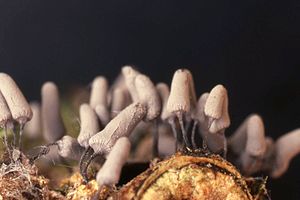Arcyria cinerea
| Arcyria cinerea | ||||||||||||
|---|---|---|---|---|---|---|---|---|---|---|---|---|

Gray calyx dusting ( Arcyria cinerea ) |
||||||||||||
| Systematics | ||||||||||||
|
||||||||||||
| Scientific name | ||||||||||||
| Arcyria cinerea | ||||||||||||
| ( Bull. ) Pers. |
Arcyria cinerea , in German sometimes called Gray Kelchstäubling called, is a common slime mold from the family Trichiidae .
features
The fruiting bodies are stalked and grow isolated or densely packed. Sometimes several have grown together on the stem base. The spore capsules are conical to cylindrical or ovoid, rarely almost spherical. When closed, they have a diameter between 0.1 and 0.9 millimeters and a height of one to four millimeters. The contained capillitium expanded only slightly. It is whitish, gray or beige in color. In rarer cases it is gray-pink, brownish or greenish in color. It can be purple-pink before maturity.
The membranous base ( hypothallus ) is common to groups of fructifications, and individual fruiting bodies are disc-shaped. It is translucent colorless to light brown. The stem is 0.2 to 1.5 millimeters long and has a wrinkled surface. It is colored like the spore capsule or a little darker to black. In transmitted light it appears light red-brown and is filled with irregular, round to broadly elliptical spore-like cysts. At the bottom, these have a diameter of 30 micrometers; they are smaller at the tip of the handle, even less than 10 micrometers in diameter.
The shell ( peridia ) disappears except for a small, flat to funnel-shaped cup. Sometimes it has fine radial folds. In transmitted light it appears yellowish, is almost smooth or has fine, short lines, some of which are arranged in a network. Sometimes small remnants of the envelope are present on the scalp.
The scalp is not very elastic, networked with small meshes and colorless to brownish. It has hardly any free ends and is firmly attached to the cup. At the points of attachment it is smooth and four to seven micrometers in diameter. Towards the top it becomes thinner (1.5–4 µm) and is mostly exclusively covered with fine spines or warts. Sometimes it also has half rings or a network drawing.
The spores are colored beige to light gray in mass. They appear almost colorless in transmitted light. They are very finely warty and have groups of larger warts. The spores measure six to eight micrometers in diameter.
The plasmodium is white, gray or yellowish in color.
Species delimitation
The typical form of the gray calyx can hardly be confused. Fructifications with spherical spore capsules that resemble Arcyria globosa are rare . This differs in the absence of the hemispherical, clearly cross-wrinkled cup. Some of the colors are somewhat similar to A. pomiformis or A. insignis . The former has a significantly wider-meshed scalp, which expands in all directions and grows singly or in small groups. Pale specimens of A. insignis differ mainly in their thin scalp, two to three micrometers in diameter.
Ecology and diffusion
The gray calyx appears particularly often together with Arcyria pomiformis on bark in moist chambers. Fructifications together with numerous other species were also observed.
The slime mold is common worldwide. It is one of the most common slime molds in Central Europe .
swell
- Hermann Neubert , Wolfgang Nowotny , Karlheinz Baumann : The myxomycetes of Germany and the neighboring alpine region with special consideration of Austria . tape 1 . Karlheinz Baumann Verlag, Gomaringen 1993, ISBN 3-929822-00-8 .